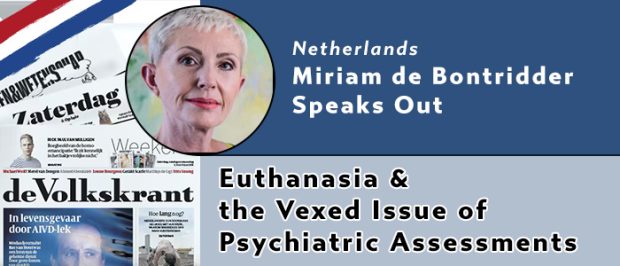August 11, 2024
No Boundaries are Crossed in Dutch Euthanasia Practice
Some Dutch psychiatrists are saying that the 2023 euthanasia of a 17-year-old proves that things are wrong with euthanasia in the Netherlands.
Miriam de Bontridder dismisses the allegations.
Milou Verhoof died by euthanasia at the age of 17 on Monday, 2 October 2023, after six years of hopeless psychological suffering.
The media, including the Volkskrant, reported that voices have been raised in psychiatrist circles claiming that the current practice of euthanasia crosses a legal boundary.
This culminated in 14 professionals writing a fire letter to the Public Prosecutor’s Office.
At the invitation of top prosecutor Rinus Otte, Professors of Psychiatry – Damiaan Denys and Jim van Os – expressed their concerns about the current practice of euthanasia.
The press release issued by the Public Prosecutor’s Office states that the letter writers requested an exploratory criminal investigation.
From what has been further reported in the media, it is said to have advocated imposing professional restrictions on psychiatrists who advocate the possibility of granting euthanasia for hopeless and
unbearable mental suffering.
Police
In particular, their arrows are aimed at psychiatrists Menno Oosterhoff and Kit Vanmechelen, who founded the Kea foundation, and at the ThaNet network, with psychiatrists Radboud Marijnissen and Sisco van Veen as chairman and vice-chairman.
The Kea foundation aims to increase knowledge about, understanding of and the possibility of euthanasia in mental illness.
The Thanet network aims to improve care for people with a euthanasia request or persistent death wish.
The letter writers wish to see action against what they call a ’stretching’ of the euthanasia law, which they say was originally intended solely to relieve suffering and hasten death with, for example, morphine in people just before they die of a physical condition.
The letter has raised controversy within the profession but also outside because instead of engaging with their colleagues, the letter writers wished to take the matter directly to the police.
Apart from that, the professional and scientific content of their argument remains open to question.
First, the professional content
After Jim van Os decried the euthanasia granted by Menno Oosterhoff to 17-year-old Milou as ‘the path of least resistance’, that patient’s mother argued in an interview with Trouw and with the Volkskrant that at some point someone may have run out of treatment and that in her daughter’s case, there was really no other solution than ‘making the greatest sacrifice of euthanasia’.
Dubious
Who better to empathise with her child’ s continued suffering than her mother?
Who is better equipped to come to the conclusion that dying is the only solution than others?
It is of dubious professionalism that a psychiatrist, who moreover has not seen the patient in question herself, apparently cannot muster even a hint of such empathy.
Then the scientific content
The regional euthanasia committee assessed the euthanasia granted to Milou carefully. Both with regard to the voluntariness and deliberateness of the death wish and with regard to the hopelessness and intolerability of the suffering and with regard to the absence of a reasonable other solution, the committee came to the opinion that these three main requirements had been met.
There was no question, the doctor providing euthanasia had fulfilled all the legal obligations.
Furthermore, the requirements for ‘careful euthanasia’ – as set out by the Dutch Psychiatric Association (NVvP) in its 2018 guideline – had also been met.
Pointless
All this means that the psychiatrists’ letter to the Public Prosecutor’s Office was a futile one.
In the case of a euthanasia which has been assessed as compliant by the regional euthanasia committee, the Public Prosecutor’s Office has, in principle, no power or duty to act. The psychiatrists who wrote the letter of complaint were duly informed of this.
However, the psychiatrists in question have a long history of repeatedly rejecting, in explicit terms, the restrictions on euthanasia as contained in the Euthanasia Act.
Given the explicit wording contained in the legislation, any claim that euthanasia in the Netherlands is intended only for people with somatic complaints and a limited life expectancy is totally out of touch with what has gone before in terms of legislative interpretation.
In 1984 and 1994 judgments, the Dutch Supreme Court has guided the practice of euthanasia. At these junctures, the Court did not impose any restrictions.
Indeed, in the 1994 ruling, the Court held that euthanasia is, in principle, also allowed for psychiatric patients who suffer hopelessly and unbearably from a mental illness, with no limited life expectancy.
During parliamentary debates prior to the introduction of the Euthanasia Act (1999-2001), the government and the legislature fully endorsed the approach of the Supreme Court.
As such, the professional association of psychiatrists, the Dutch Psychiatric Association, ‘NVvP’, has been advising its members to take euthanasia requests seriously since 1998.
Yet relatively few psychiatrists have followed this advice.
The Kea Foundation and the ThaNet network essentially do nothing more than shape this twenty-five-year-old advice from the professional association.
Indeed, in 2018, the NVvP emphasised this advice in the latest version of their guidelines.
Contrary to what the letter writers claim, the limits set by the Euthanasia Act have not been stretched.
Therefore, there can be no argument that current euthanasia practice crosses legal boundaries.
About the Author
Miriam de Bontridder is a Deputy Judge and Member of the Supervisory Council of NVVE.
